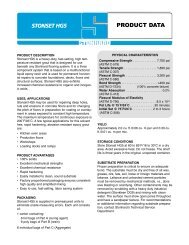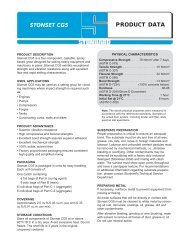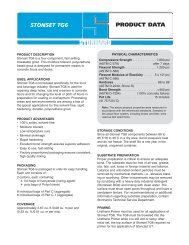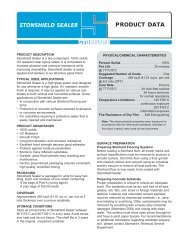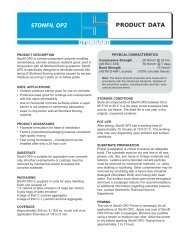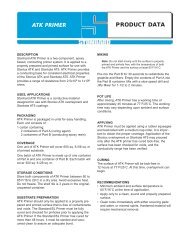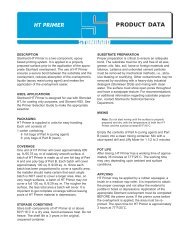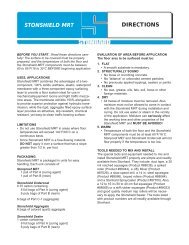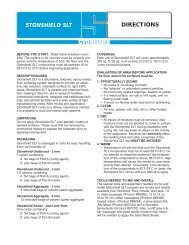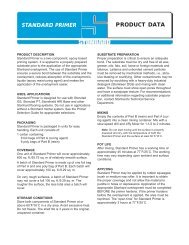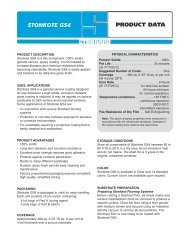STONCLAD HT - Directions.pdf - StonCor Europe
STONCLAD HT - Directions.pdf - StonCor Europe
STONCLAD HT - Directions.pdf - StonCor Europe
Create successful ePaper yourself
Turn your PDF publications into a flip-book with our unique Google optimized e-Paper software.
<strong>STONCLAD</strong> <strong>HT</strong><br />
DIRECTIONS<br />
BEFORE YOU START...Read these directions carefully!<br />
The surface to be covered must be properly prepared,<br />
and the temperatures of both the floor and the<br />
Stonclad GS components must be at least 16˚C BE-<br />
FORE beginning application.<br />
USES/APPLICATIONS<br />
Stonclad <strong>HT</strong> is a four-component, epoxy based floor<br />
surfacing system. It was specifically designed for surfacing<br />
and patching industrial floors exposed to corrosive<br />
spillages and abrasive wheeled traffic.<br />
After mixing and application, the Stonclad <strong>HT</strong> cures<br />
quickly, forming an exceptionally durable, slip-resistant<br />
floor surface. These properties make Stonclad <strong>HT</strong><br />
ideal for use in areas where the floors are subject to<br />
impact, heavy or abrasive traffic, and spillages of<br />
acids, alkalis, solvents, fats, oils, sugars and other<br />
corrosive substances.<br />
LIMITATIONS<br />
• Do not use Stonclad <strong>HT</strong> in areas where floor temperatures<br />
will exceed 93˚C on a continuous basis.<br />
• Do not apply Stonclad <strong>HT</strong> over gypsum based<br />
products, asphalt, mastic or painted surfaces.<br />
These must first be removed by mechanical means<br />
to expose the substrate prior to applying primer and<br />
overlayment.<br />
PACKAGING<br />
Stonclad <strong>HT</strong> is packaged in units for easy handling.<br />
Each unit consists of:<br />
2 cartons, each containing:<br />
- 6 foil bags of Part A (curing agent)<br />
- 6 poly bags of Part B (resin)<br />
2 cartons, each containing<br />
- 6 bags of Part C-2 (pigments)<br />
12 individual bags of Part C-1 (aggregate)<br />
COVERAGE<br />
Each unit of Stonclad <strong>HT</strong> will cover approximately<br />
18.58 sq. m of surface at a nominal 6 mm thickness. If<br />
the surface being covered is rough, additional material<br />
should be allowed for the area.<br />
A batch of Stonclad <strong>HT</strong> is made up of one foil bag of<br />
Part A, one poly bag of Part B, one bag of Part C-2<br />
and one bag of Part C-1. When mixed, each batch will<br />
cover approximately 1.49 to 1.58 sq. m.<br />
EVALUATION OF AREA BEFORE APPLICATION<br />
The floor area to be surfaced must be:<br />
1. STRUCTURALLY SOUND<br />
• No loose or crumbling concrete.<br />
• No “laitance” or unbonded cement particles.<br />
• No previously applied sealers or paints.<br />
• If a metal surface, no rust or mill scale, and no flexing<br />
under load.<br />
• If wood, no flexing under load and no splintering.<br />
2. CLEAN<br />
• No wax, grease, oils, fats, dirt or other foreign matter.<br />
• Metal surfaces must be free of oil, grease and other<br />
similar contaminants.<br />
• Wood surfaces must not be oil-impregnated or<br />
badly splintered.<br />
3. DRY<br />
• All traces of moisture must be removed. Also, moisture<br />
must not be allowed to come in contact with<br />
the Stonclad <strong>HT</strong> during installation and curing. Do<br />
not use water or steam in the vicinity of the application.<br />
Moisture can seriously affect working time<br />
and other properties of the Stonclad <strong>HT</strong> and MUST<br />
BE AVOIDED!<br />
4. WARM<br />
• Temperature of both the floor and the Stonclad <strong>HT</strong><br />
components must be at least 16˚C. Do not attempt<br />
to install the material if the temperature of the components<br />
is above 30˚C. High temperatures will<br />
cause the material to harden (cure) more quickly<br />
than desired. If the temperature of the components<br />
is 16˚C or lower, the Stonclad <strong>HT</strong> will be stiff and<br />
difficult to apply.<br />
TOOLS NEEDED TO MIX AND INSTALL<br />
When installing Stonclad <strong>HT</strong>, use JB Power Blenders,<br />
5 gallon mixing pails, blender timers, a screed box, a 3<br />
in. x 12 in. steel finishing trowel and a power trowel.<br />
ARRANGEMENT OF THE MIXING AREA<br />
The mixing area should be set up using the following<br />
guidelines:<br />
1. Position two JB Power Blenders (Product #88002)<br />
side by side with the Blender Timer (Product<br />
#87008) between them (Figure 1).<br />
01/02 <strong>STONCLAD</strong> <strong>HT</strong> - DIRECTIONS 1/4
By structuring the sequence of operations as just described,<br />
there should always be a fresh batch of Stonclad<br />
<strong>HT</strong> ready to be transferred to the workers who will<br />
be applying it to the floor. Also, by following the structured<br />
sequence of operations, one can eliminate the<br />
chance of mistakes occurring.<br />
Note: Once the material has been mixed, it has an approximate<br />
20 minute working time.<br />
FIGURE 1<br />
2. Carefully arrange the cartons of Part A and Part B<br />
to one side of the two blenders.<br />
Note: When handling cartons containing Part A and Part B,<br />
you will see a “caution” notice printed on them. The notice<br />
warns you to use only a SHALLOW cut (6 mm or less) when<br />
using a knife to open the carton. Using a knife with a longer<br />
blade risks the possibility of cutting through the carton and into<br />
the plastic and foil bags inside.<br />
PLACING AND FINISHING <strong>STONCLAD</strong> <strong>HT</strong><br />
1. A Screed Applicator (Figure 2) is used to apply the<br />
mixed Stonclad <strong>HT</strong> to the floor. Before use, the<br />
Screed Applicator must be set to apply an 8 mm<br />
layer of material. This will result in a nominal 6 mm<br />
topping after the material has been compacted and<br />
trowel finished.<br />
3. The bags of Part C’s should be lined up on the<br />
other side of the two blenders.<br />
4. Set the blender timer for 60 seconds.<br />
5. Place an empty carton close to the blenders, where<br />
it will be handy for trash and storage of the blender<br />
paddle between mixing cycles.<br />
PRIMING<br />
Stonhard’s <strong>HT</strong> Primer must be applied to the prepared<br />
floor surface before installing Stonclad <strong>HT</strong>. Use of <strong>HT</strong><br />
Primer ensures a secure bond to the substrate, prevents<br />
draining of liquids from the Stonclad <strong>HT</strong> and<br />
makes application of the overlayment easier. See <strong>HT</strong><br />
Primer Product Data for details. <strong>HT</strong> Primer must remain<br />
tacky during the installation of Stonclad <strong>HT</strong>. If<br />
the primer becomes tack-free, the area must be reprimed<br />
prior to continuing the application.<br />
MIXING <strong>STONCLAD</strong> <strong>HT</strong><br />
1. Empty the contents of one foil bag of Part A (liquid)<br />
into a 5 gallon mixing pail.<br />
2. Then, empty the entire contents of one poly bag of<br />
Part B (liquid) into the mixing pail containing the<br />
Part A and add a bag of Part C-2.<br />
Note: It is important to allow sufficient time for ALL of the<br />
Part A and Part B liquids to drain into the mixing pail.<br />
FIGURE 2<br />
Note: The Stonclad <strong>HT</strong> has already begun to cure, so troweling<br />
must proceed without delay.<br />
2. After screeding the Stonclad <strong>HT</strong>, steel finishing<br />
trowels are used to compact and smooth the surface<br />
of the material (Figure 3). Use enough pressure<br />
to compact the Stonclad <strong>HT</strong> to the required<br />
6 mm thickness. Then, holding the trowel at a<br />
slightly lower angle, smooth out any trowel marks. If<br />
the mortar “pulls”, creating a rough or open surface,<br />
either the trowel has become sticky or it is being<br />
held at the wrong angle. Keep the trowel clean by<br />
frequently cleaning it with scouring pads and warm,<br />
soapy water, remembering to WIPE IT DRY BE-<br />
FORE USING IT AGAIN on the Stonclad <strong>HT</strong>. The<br />
finished Stonclad <strong>HT</strong> surface should be level, free<br />
of trowel marks and tightly closed to prevent a porous<br />
topping.<br />
3. Transfer the mixing pail to a JB Blender, insert the<br />
mixing paddle (Product #89000) and activate the<br />
timer to start the blender.<br />
4. When the blender stops, re-activate the timer and<br />
immediately pour the entire contents of one bag of<br />
Part C-1 (aggregate) into the rotating mixing pail.<br />
Allow the three components to mix for the entire cycle.<br />
5. When the blender stops, scrape off any mixed material<br />
that may be adhering to the mixing paddle,<br />
then place the paddle in the empty carton, where it<br />
will be on hand for use when mixing the next batch.<br />
Remove the mixing pail and deliver the mixed material<br />
to the workers who will be applying it to the<br />
floor.<br />
FIGURE3<br />
3. In large, open areas, a power trowel is used to<br />
compact and smooth the surface of the material<br />
(Figure 4). (See Stonclad PT <strong>Directions</strong> for further<br />
information.)<br />
01/02 <strong>STONCLAD</strong> <strong>HT</strong> - DIRECTIONS 2/4
FIGURE 4<br />
4. The mixing, screeding, troweling procedure is repeated<br />
as needed until the entire area has been<br />
covered. Coverage and thickness can usually be<br />
judged by the eye, but DO check the actual thickness<br />
at frequent intervals during the entire installation.<br />
5. Where Stonclad <strong>HT</strong> does not abut a vertical surface,<br />
trowel the Stonclad <strong>HT</strong> into a chase (groove)<br />
cut into the concrete.<br />
6. If applying a cove, the cove should be troweled<br />
along with the floor to provide a seamless transition.<br />
The same Stonclad <strong>HT</strong> material is used for the<br />
cove base and the floor.<br />
COATING <strong>STONCLAD</strong> <strong>HT</strong><br />
To achieve maximum performance from a Stonclad <strong>HT</strong><br />
floor, application of a Stonhard coating is recommended.<br />
Application of Stonkote <strong>HT</strong>4 will improve the<br />
cleanability and appearance of the floor while enhancing<br />
the chemical and abrasion resistance. Before coating<br />
a Stonhard floor, all trowel marks and surface imperfections<br />
must be removed to produce a smooth,<br />
level surface. Grind the floor using a floor grinder with<br />
medium stones (Figure 5) and vacuum to remove all<br />
dust particles (Figure 6). Mixing and application instructions<br />
vary for each coating. See the appropriate<br />
Product Data sheet for details.<br />
FIGURE 5<br />
HARDENING TIME<br />
At 22˚C allow:<br />
• 8 hours for foot traffic.<br />
• 24 hours for moderate wheeled loads.<br />
• 48 hours for common industrial spillages and heavy<br />
traffic.<br />
• 72 hours for strong chemical spillages.<br />
Note: When installing Stonclad <strong>HT</strong> in a cold environment,<br />
temperature must be kept at 16˚C for at least 18 hours after<br />
installation before the cooling system can be turned<br />
back on. After the Stonclad <strong>HT</strong> is cured, cooling of the area<br />
must be done slowly (max. 12˚C per 24 hour period) to<br />
avoid cracking or delamination of the Stonclad <strong>HT</strong>.<br />
CLEANING UP<br />
Clean all equipment IMMEDIATELY AFTER USE with<br />
scouring pads and warm, soapy water or with mineral<br />
spirits. Hardened material will require mechanical<br />
means of removal.<br />
IMPORTANT: If any unusually long delay should arise,<br />
such as a break for lunch, it will be necessary to completely<br />
clean all mixing paddles and pails BEFORE<br />
ceasing operation. THIS IS EXTREMELY IMPOR-<br />
TANT! This will prevent the future contamination of<br />
new batches of Stonclad <strong>HT</strong> with particles of partially<br />
cured material when the mixing operation resumes.<br />
The presence of such particles can seriously affect<br />
the troweling and finishing of the floor, and MUST BE<br />
AVOIDED!<br />
FIGURE 6<br />
CAUTION<br />
Avoid contact with Parts A and B as they may cause<br />
skin and/or eye irritation. In case of contact, immediately<br />
flush the area with copious amounts of clean<br />
water for at least 15 minutes and seek medical attention.<br />
Workmen should cover hands with rubber gloves.<br />
Wash hands thoroughly with SOAP AND WATER after<br />
use, and before eating, smoking, etc. Use only with<br />
adequate ventilation.<br />
STORAGE<br />
Store all components of Stonclad <strong>HT</strong> between 16 to<br />
30˚C in a dry area. Avoid excessive heat and do not<br />
freeze. The shelf life is three years in the original, unopened<br />
container.<br />
DO NOT STACK SKIDS OF PART C ON PARTS A &<br />
B - LEAKAGE MAY OCCUR<br />
01/02 <strong>STONCLAD</strong> <strong>HT</strong> - DIRECTIONS 3/4
IMPORTANT :<br />
Stonhard believes the information contained here to be true and accurate as of the date of publication. Stonhard makes no warranty, expressed or implied, based on this literature and assumes<br />
no responsibility for consequential or incidental damages in the use of the systems described, including any warranty of merchantability or fitness. Information contained here is for evaluation<br />
only. We further reserve the right to modify and change products or literature at any time and without prior notice..<br />
A Division of<br />
www.stoncor-europe.com<br />
Belgium +32 67493710 Spain/Portugal +351 707200088 Germany +49 240541740<br />
France +33 160064419 Great-Britain +44 1256336600 Netherlands +31 165585200<br />
Poland +48 422112768 East <strong>Europe</strong>/Scandinavia +31 165585200 Italy +39 02253751<br />
01/02 <strong>STONCLAD</strong> <strong>HT</strong> - DIRECTIONS 4/4




